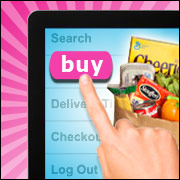
This story was originally published on July 9, 2013, and is brought to you today as partof ourBestofECT News series.
Shopping for groceries might not be top of mind for many rail commuters — at least, not until they see one of Peapod’s virtual supermarkets in a train station.
Peapod, which has long been at the forefront of online grocery sales, has pushed its virtual offerings into the real world, and its strategy appeals to people who otherwise might not have considered digital grocery shopping.

The company has more than 100 virtual stores at rail stations throughout its markets in Boston, Connecticut, New York, New Jersey, Philadelphia, Washington, D.C., and Chicago.
Peapod’s virtual store campaign motivates consumers “to download the mobile app, which allows them to start shopping on-the-go while they’re out and about in their communities — at a train station, commuting to and from work, at a local rec center for their kids’ soccer games, [or] at a coffeeshop,” Bradley Porter, Peapod’s director of marketing, told the E-Commerce Times.
Shop While Waiting for the Train
The virtual store program uses billboards that are stocked with QR-coded products that can be scanned with mobile devices and purchased on site. While people wait for trains, they can do their grocery shopping right on the platform.
“The campaign was designed to motivate people to download the Peapod mobile app, which they can do by scanning the QR code on the Virtual Store signs, and to shop while they’re on the go via their mobile devices,” explained Porter.

“Commuters [are] able to launch the Peapod mobile app, scan a few household staples while waiting for their trains, and then finish their shopping and schedule delivery or pick up during their ride to work. [It’s] easy and convenient.”
Peapod’s virtual billboard concept is also making its way out of train stations and into a variety of other real-world locations.
“Now, with the virtual stores posted at rec centers, on a digital billboard that roams, on coffee sleeves and on human billboards, Peapod is taking the ‘shop anywhere, anytime’ message directly to consumers where they live and play,” said Porter.
Brave New World of Food
Peapod’s strategy is at the forefront of a digital revolution in food marketing, sales and purchasing, and many other companies are building similar models.
“For the food industry, mobile technology has been extremely innovative recently, and more is coming,” said Brian Todd, president and CEO of The Food Institute.
“Food makers and retailers are collaborating more and more to promote products and increase awareness of their products,” he told the E-Commerce Times. “Smartphones are being utilized to scan products in stores to find out product information, even showing what fields the food was grown in.”
Along with the digitizing of food marketing and sales comes the growth of data about the consumers making those purchases.
“Using Big Data from frequent shopper cards is extremely innovative,” said Todd. “Knowing what its customers have purchased and other data to aid them in their shopping have made this an extremely exciting area and one that we will likely see even more innovation from in the future.”
Ideally, many of these technologies will save people time and make the process of shopping for groceries more efficient. That efficiency also extends to food manufacturers and marketers.
“Much of the technology is time-saving, so consumers can access information right on their smartphones in the store, or in some cases [they can be reminded] to pick up an item they regularly buy when shopping,” said Todd. “Ultimately, it can make ordering and inventory levels for retailers more easily managed.”
Nutritional and other data about food also is valuable in the digital grocery age, and companies such as Gladson are playing a role in collecting, managing, and distributing this data to retailers and consumers.
“Shoppers are becoming more sophisticated and discriminating in choosing products,” Steve Cole, Gladson’s chief marketing officer, told the E-Commerce Times.
“They’re increasingly looking for more detailed information from manufacturers and retailers,” he continued. “For example, some shoppers are looking for products that are friendly to the environment or are gluten-free or are all-natural. We work closely with the industry to make sure we capture and deliver the information shoppers want.”
‘The Shopper’s Advocate’
Many traditional brick-and-mortar grocery stores are offering online ordering and delivery, and companies like MyWebGrocer help these retailers by providing e-commerce platforms, producing digital circulars, facilitating special orders, and managing online marketing.
“People have learned to trust the online environment, and they’re looking to do their normal day-to-day affairs online” Sophie Huang, MyWebGrocer’s senior vice president of product strategy and strategic initiatives, told the E-Commerce Times. “People want to be able to get themselves organized and get their shopping done quickly, and they want to do it within their environment with their own device.”
MyWebGrocer’s e-commerce platform allows grocery stores to provide a personalized experience to their customers, who can create shopping lists, peruse sale items, access recipes, manage their rewards points, and order their groceries.
The company also works with retailers to train and manage personal shoppers, who choose items for orders that can then be picked up at the store or delivered to customers. These shoppers, in fact, have become a vital part of many grocery stores’ online offerings — making digital grocery shopping perhaps even more personal than it traditionally has been.
“The personal shopper becomes the shopper’s advocate in the store,” explained Huang. “That personal shopper has the run of the store, knows where everything is, and will go out of their way to get the best head of lettuce.”












































Social Media
See all Social Media